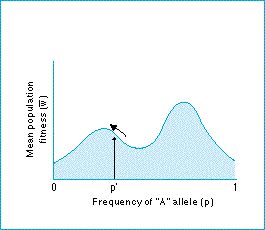Multi-locus population genetics - What would real adaptive topographies look like?

Fitness surfaces with multiple peaks
Wright suggested that real topographies would have multiple peaks, separated by valleys, with some peaks higher than others.
When the environment changed, and competing species evolved new forms, the shape of the adaptive topography for a population would change too. The surface would also change shape when a new mutation arose. A new allele at a locus may interact with genes at other loci differently from the existing alleles, and the fitnesses of the genes at the other loci will then be altered; genetic changes will take place at other loci to adjust to the new mutant.
All the time, natural selection will be a hill-climbing process, directing the population up toward the nearest peak. When the surface changes, the direction to the nearest peak may change, and selection will then send the population off in the new upward direction. However, natural selection, even in so far as it is a hill-climbing (i.e., mean fitness maximizing) process, is only a locally hill-climbing process. As the figure shows the local fitness peak could be in the opposite direction from a higher, or the global, peak. Natural selection, however, will direct the population to the local peak.
Because natural selection seeks out only local peaks, it may not always allow a population to evolve the best possible adaptations. A population could be stuck on a merely locally adaptive peak. Wright put forward the shifting balance theory as a means of crossing from local to global peaks.
Figure: a two peaked fitness landscape with local and global maxima. Natural selection will take a population with gene frequency p' toward the local peak, and away from the peak with highest average fitness.
| Next |



